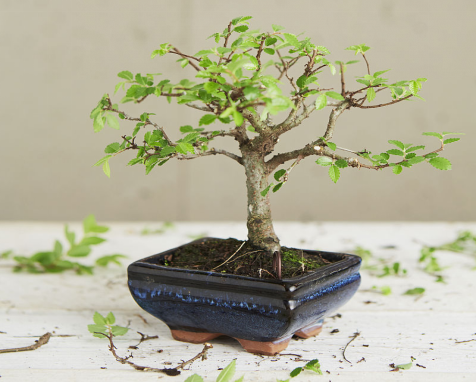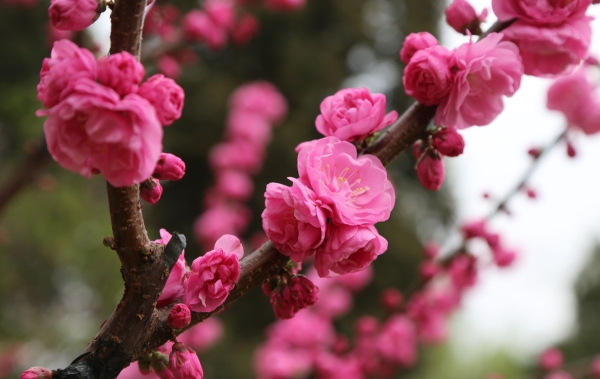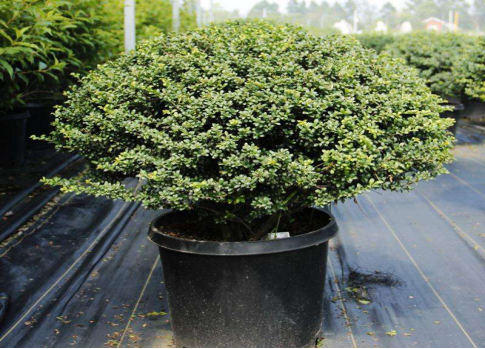Key points of conservation of elm bonsai
1. Elm trees are slightly shady and like light very much, so they should be watered more in summer and autumn and avoid exposure to the sun.
two。 Elm trees can be pruned all year round, just remember that in order to prevent excessive bleeding and withered branches, elm trees should not be trimmed on rainy days.

3. Elm likes humus mixed soil (PH5.5-6).
4. During the growing period (April-October), elm trees apply thin cake fertilizer or organic fertilizer every half a month. In winter, about ten days before entering the house, we need to water cake fertilizer or organic fertilizer (mainly phosphorus and potassium fertilizer). Apply cake crumbs again after entering the room.
5. The growing period is very suitable for pruning elm trees, and we can often cut off cross branches and fine branches for it at this time. And after 2 days of pruning, urea was sprayed on the leaves.
6. What should we do when we encounter diseases and insect pests such as longicorn beetles, shell insects, golden flower insects and so on? The editor recommends using 1500 times of 80% dichlorvos or 2000 times of wind and lightning.
The above are the methods of making elm bonsai and points for attention. Have you learned it? Are you eager to have a potted elm bonsai as soon as possible? Let's get moving!
Key points of elm bonsai maintenance, how to make and maintain elm bonsai
❤ `.,.''recommend:
❤ transports bamboo
❤ Yuan Baoshu
❤ rockery bonsai
❤ Pine Bonsai
❤. Decorate your home and enjoy every minute of your life! This article comes from [Decoration Information]
The posture of the elm is chic and straight, the bark is rough and many longitudinal cracks are dark gray, but its twigs are soft and suitable for staggered climbing, and the ancient elm stump is even more elegant. Although it seems to have long been decayed by the years, the branches and leaves still grow normally, giving people the meaning of ancient trees in spring. The production of elm bonsai some are intertwined, and even turn decay into magic, do not have a charm.
The production of elm bonsai: 1. Prepare tile pots equipped with plain sand for planting newly dug old piles of elm trees, also known as "raising piles". Pile cultivation is generally carried out from late autumn to spring, and the survival rate is the highest about three months before elm sprouting. 2. the stump should be transplanted with guest soil, and it should be carried out before sprouting leaves in winter and spring. After planting, wrap the stem with rice straw mixed with yellow mud water, and often water it to ensure that the soil and straw are moist. 3. Before planting, the roots and branches should be trimmed, and there is often viscous sap flowing out of the cut, so it should be noted that the viscous tree liquid should not exudate too much, otherwise it will seriously affect the survival rate. To prevent this from happening, we can seal the cut with wax and sprinkle it with fine sand so that it can be effectively avoided.
4. Compacting the soil after planting, there is no need to water at this time, then spray clean water to the branches 1-2 times a day, and then water again 3-4 days later, and finally, as long as it is not dry, do not water, do not let the soil accumulate water. 5. According to the basic form of the old pile, the elm bonsai is modeled, and different forms of bonsai are made by banding, pruning and other forms. Modeling time does not pay special attention to the period, can be in the dormant period after falling leaves, can also be in the growing period, but must not be in the budding period to do modeling.
Conservation of elm bonsai:
1. Lighting: strengthen the illumination of elm bonsai. Elm bonsai like sunshine, shade tolerance is poor, the production of bonsai should be placed in a sunny place. Lack of sunlight, it will only grow branches and leaves very ugly, but also easy to cause insect pests. 2. Watering: although elm likes to grow in wet places, it is also afraid of water stains. Therefore, each watering should be thoroughly watered in the morning and evening at the height of summer, and the basin soil must be kept moist without stagnant water.
3. Fertilization: Elm bonsai need not be fertilized too much, as long as it is applied once each year in early spring and early autumn. 4. Pruning: because the growth of elm is very strong, we need to prune diligently to maintain the ornamental value of elm bonsai. Pruning and shaping can be carried out in autumn, cutting off useless branches and diseased branches, and then pruning. 5. Diseases and insect pests: the elm bonsai is often harmed by aphids and clams. We can spray it with omethoate diluted with 1000 times water.
Conclusion: the elm stump is not only used for bonsai viewing, but also can be used as a tree embellished in the courtyard. In the south of the Yangtze River, it has become "where there is a village, there must be elm". The above is the introduction of the editor. Will you make elm bonsai after reading it? How much do you know about its maintenance? Friends who like bonsai, plant one quickly!
▣ Desert Rose Culture ▣ Blue Magic Flower words ▣ Gardenia leaves yellowing ▣ rose planting techniques ▣ touch incense how to raise ▣ daffodils ▣ rose cultivation techniques ▣ longevity flower culture methods ▣ mulberry culture methods
Elm bonsai picture elm bonsai conservation key points, how to make and maintain elm bonsai
? Related recommendations:
? Open and transport bamboo
? Yuanbao tree
? Rockery bonsai
? Pine bonsai
? Decorate your little home and enjoy every minute of your life! This article comes from [Decoration Information]
The posture of the elm is chic and straight, the bark is rough and many longitudinal cracks are dark gray, but its twigs are soft and suitable for staggered climbing, and the ancient elm stump is even more elegant. Although it seems to have long been decayed by the years, the branches and leaves still grow normally, giving people the meaning of ancient trees in spring. The production of elm bonsai some are intertwined, and even turn decay into magic, do not have a charm.
The production of elm bonsai: 1. Prepare tile pots equipped with plain sand for planting newly dug old piles of elm trees, also known as "raising piles". Pile cultivation is generally carried out from late autumn to spring, and the survival rate is the highest about three months before elm sprouting. 2. the stump should be transplanted with guest soil, and it should be carried out before sprouting leaves in winter and spring. After planting, wrap the stem with rice straw mixed with yellow mud water, and often water it to ensure that the soil and straw are moist. 3. Before planting, the roots and branches should be trimmed, and there is often viscous sap flowing out of the cut, so it should be noted that the viscous tree liquid should not exudate too much, otherwise it will seriously affect the survival rate. To prevent this from happening, we can seal the cut with wax and sprinkle it with fine sand so that it can be effectively avoided.
4. Compacting the soil after planting, there is no need to water at this time, then spray clean water to the branches 1-2 times a day, and then water again 3-4 days later, and finally, as long as it is not dry, do not water, do not let the soil accumulate water. 5. According to the basic form of the old pile, the elm bonsai is modeled, and different forms of bonsai are made by banding, pruning and other forms. Modeling time does not pay special attention to the period, can be in the dormant period after falling leaves, can also be in the growing period, but must not be in the budding period to do modeling.
Conservation of elm bonsai:
1. Lighting: strengthen the illumination of elm bonsai. Elm bonsai like sunshine, shade tolerance is poor, the production of bonsai should be placed in a sunny place. Lack of sunlight, it will only grow branches and leaves very ugly, but also easy to cause insect pests. 2. Watering: although elm likes to grow in wet places, it is also afraid of water stains. Therefore, each watering should be thoroughly watered in the morning and evening at the height of summer, and the basin soil must be kept moist without stagnant water.
3. Fertilization: Elm bonsai need not be fertilized too much, as long as it is applied once each year in early spring and early autumn. 4. Pruning: because the growth of elm is very strong, we need to prune diligently to maintain the ornamental value of elm bonsai. Pruning and shaping can be carried out in autumn, cutting off useless branches and diseased branches, and then pruning. 5. Diseases and insect pests: the elm bonsai is often harmed by aphids and clams. We can spray it with omethoate diluted with 1000 times water.
Conclusion: the elm stump is not only used for bonsai viewing, but also can be used as a tree embellished in the courtyard. In the south of the Yangtze River, it has become "where there is a village, there must be elm". The above is the introduction of the editor. Will you make elm bonsai after reading it? How much do you know about its maintenance? Friends who like bonsai, plant one quickly!
▓ recommended reading
? Is touching incense poisonous? Desert rose farming? The floral words of the blue witch? The leaves of gardenia turn yellow? Rose planting techniques? How to keep touch incense? The words of daffodils? Rose planting techniques? Longevity flower culture method? Culture method of Fusang
- Prev

Matters needing attention in culturing Prunus mume
Elm leaf plum needs frequent pruning during its growth, and it is very resistant to pruning. Pruning and combing the branches can reduce the evaporation of water, which can reduce the pressure on the roots.
- Next

Maintenance of potted holly
Soil holly, like warm climate, have a certain degree of cold resistance, like moist semi-shade and fertile soil, but can also grow well in general soil, environmental requirements are not strict. The planted Dongqing seedlings can grow naturally after watering once, and they can be watered once every half a month according to their conditions.
Related
- Fuxing push coffee new agricultural production and marketing class: lack of small-scale processing plants
- Jujube rice field leisure farm deep ploughing Yilan for five years to create a space for organic food and play
- Nongyu Farm-A trial of organic papaya for brave women with advanced technology
- Four points for attention in the prevention and control of diseases and insect pests of edible fungi
- How to add nutrient solution to Edible Fungi
- Is there any good way to control edible fungus mites?
- Open Inoculation Technology of Edible Fungi
- Is there any clever way to use fertilizer for edible fungus in winter?
- What agents are used to kill the pathogens of edible fungi in the mushroom shed?
- Rapid drying of Edible Fungi

